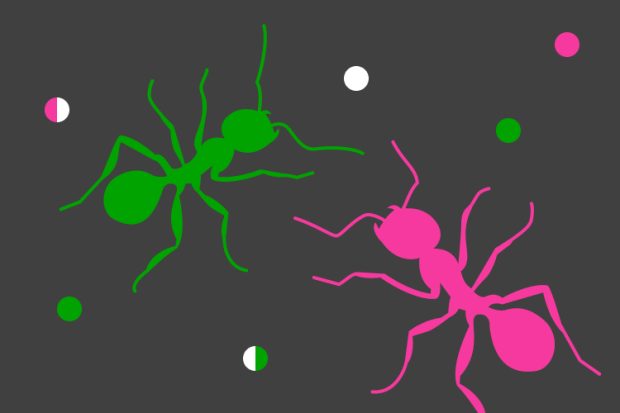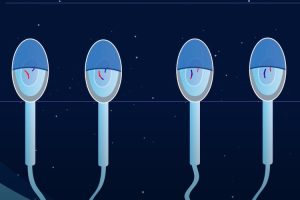Genetics and Intelligence
Robert Plomin on IQ tests, genetic predispositions to higher or lower intelligence, and the Flynn Effect

Pheromones are invisible chemical signals between members of the same species, and they are important because they are possibly some of the universal ways of communication across the animal kingdom.
Pheromones are chemical signals that travel between the emitting animal and the receiver, usually carried either in air or water. When they reach the receiver, the receiving animal, they are almost always detected through the sense of smell. In the case of mammals, that is through the nose; in insects and in crustaceans like lobsters, it is the antenna. Specialized nerve cells in the nose or in the antenna that have a particular kind of receptor that binds with a pheromone molecule are responsible for detecting the pheromone. When the pheromone molecule binds to the receptor, it excites the nerve, which sends a message to the brain that the pheromone has been detected. What happens next depends on the signal and the animal. If it is a male moth that has detected a female sex pheromone, he takes off, and by series of responses to the pheromone, he eventually finds the female. But pheromones are used in all sorts of contexts. Another pheromone is one given off by mother rabbits in their milk. This mammary pheromone stimulates the rabbit pup to find the nipple. This is a very specific response, and it enables the rabbit pup to find the nipple very quickly: Baby rabbits need to do this because they only have three or four minutes a day to take milk from their mother.
Pheromone signals work in much the same way as any other kind of signal, except that a molecule has to travel from the signaler to the receiver. That makes them very good to use at night, but it does mean that you have to be in reasonably close proximity. So it is different from a sound or a visual signal, which potentially can work from much greater distances.
Pheromones have actions in connection with all life stages and all kinds of situations. It depends on the species. So it was mentioned that sex pheromones in moths and in dogs, and the mammary pheromone in rabbits. In social insects, including bees, wasps, ants, and termites, there are an enormous number of different kinds of pheromones that are involved in a wide variety of different kinds of behaviors. For example, alarm pheromones are found in many social insect species. A honeybee’s nest is a very rich resource, which attracts bears (and humans) who want to steal the honey. Bees have a collective defense, and when a bee stings a bear, the sting remains in the skin of the bear and continues to release an alarm pheromone. This acts as a beacon that attracts other bees to attack the bear. Ants’ alarm pheromones are important when colonies are fighting: the pheromone draws more soldiers into the battle. Of course, ants also have trail pheromones which are how they are recruited in large numbers by scouts for a source of food like a picnic.

There are also other kinds of pheromones that have an effect not on behavior directly but via changes in the physiology of the receiving animal. For example, there are pheromones in mice, which seem to either slow down or speed up sexual maturity. They slow down puberty, for example. There are other pheromones that, unlike most pheromones, bypass the olfactory system. For example, in honeybees, the food fed to honey bee larvae, royal jelly, contains pheromones, including a protein called royalactin. If the honeybee larvae are fed exclusively with royal jelly, they will become queens. If they are also fed with pollen instead, they become workers. Pheromones in the royal jelly act by changing gene expression, switching development into a queen.
Some 80 years before the first pheromone was identified, the first state entomologist in New York State, Joseph Lintner, had some female silk moths in the window of his office. Through the open window, their pheromone attracted large male moths that were fluttering over the sidewalk, attracting a crowd of people who gathered down below. Lintner speculated that the strong attraction must surely be to some kind of chemical given off by the female moths. If this attractive chemical could be synthesized and produced in large quantities, then perhaps it could be a way to control pest moths. The adult moths don’t cause any problems; it’s the caterpillars that do the damage to apples or other crops. So if you can disrupt mating to prevent the adults from finding each other and fertilizing the eggs, then you could stop the caterpillars. In the 1960s, the first experiments were made to test this idea in orchards and in corn and cotton fields. In the decades since it has turned out to be a very successful technique. It often provides a solution when pesticides have stopped working because the pest moths have become resistant to the pesticide. Pheromones provide an environmentally friendly and cost-effective way of pest control, not killing the moths but by preventing adults from meeting, so we have none of the pest larvae. Mating disruption and pest control using pheromones are used on at least 10 million hectares around the world: on cotton in the USA, on tomatoes in Mexico, on aubergine(eggplant) in Pakistan, and on peaches in South Africa. Unlike pesticides, synthetic pheromones do not kill predatory insects and other natural enemies, so these can help keep pest insect populations in check. However, one challenge for pheromones for pest control is that their species-specificity means that each species’ pheromone has to be investigated and its delivery optimized for effective pest control.
Human pheromones have been speculated about for a long time. It is an attractive idea, and certainly, in terms of traditional folk knowledge, it goes back a long way. There are stories about a central European village man keeping a handkerchief in their armpit and waving it in a village dance to the woman of their desires, who instantly, of course, fall in love. The real stories, in some ways, are a bit more disappointing. If you search on the web for human pheromones, an enormous number of commercial sites will try to sell you what they claim is the real thing. And if you look at the scientific literature, there are also many studies that claim to show the effects of what they usually call “putative human pheromones”. A few years ago, I was intrigued by the claims and looked for the source of the ideas in the scientific literature. What I found really surprised me: it turned out that most of the published studies could be traced back to one paper in 1991. This was a study of two molecules, androstadienone, and estratetraenol, which were proposed as the human pheromones for males and females, respectively. However, there is no evidence provided in the paper, which was in conference proceedings. The methods section of the paper describing the molecules simply said that they were supplied by the Erox Corporation. So I wondered what the Erox Corporation had done. And there, all I found was a patent, in fact, a series of patents, which described in detail the synthesis of the molecules but provided almost no evidence that these were human pheromones. What kind of evidence would actually really show they were pheromones? For that, you can go back to the silk moth work in 1959. In his pioneering study, Butenandt laid down what has become the gold standard for discovering and demonstrating a real pheromone.
First, you have to carefully isolate the molecules, and then you have to test if the molecules in your extract have the same effect as the natural secretion. You then identify the molecules, synthesize them and show that your synthesized molecules reproduce the original effect which you had observed. When it comes to humans, it turns out that those crucial steps have never been done. These two molecules appeared almost to have been plucked out of the air and deemed to be “pheromones”. It was simply said that there were pheromones, but there was no evidence from proper testing, no evidence that they have a particular behavior or physiological response when applied. Basically, there was no evidence. What’s happened is literature has grown up taking as a matter of faith that these molecules really are pheromones. And what I did in my review in 2015 was a show there are lots of reasons for thinking that these molecules are probably not pheromones. The molecule claimed to be a female pheromone has only ever been found in the urine of women in their third semester of pregnancy, which would make it a very unlikely sex pheromone for attracting a mate. The purported male “pheromone” has been found in human armpits. But so have hundreds and hundreds of other molecules. So there is simply no reason to choose these molecules. I am afraid that that is where we are so far as the sex pheromones are concerned.
The first human pheromone to be robustly identified probably won’t be a sex pheromone, though that has attracted the most interest in the past. Instead, the likely pheromone is one that may be involved in communication between mothers and babies. To identify a pheromone, you need a simple experiment that you can repeat reliably when you go through the stages of identifying the molecules. We have such a potentially smell-driven behavior and a bioassay in the interactions between human mothers and their babies. This is work done in France by Professor Benoist Schaal. His team has shown that there are secretions produced around the nipple of lactating mothers that seem to cause any baby, not just their own, to start to suckle. The researchers have developed a simple bioassay, recording the suckling responses of newborn babies to secretions, which may allow them to track down and identify the molecules in the pheromone, should one exist. It may be that there is a human pheromone equivalent to the rabbit mammary pheromone.
In terms of exciting things that are going on in the world of pheromones generally, it’s turned out that this is a very exciting way to study both animal behavior and neuroscience. What we have in the moth is an identified pheromone given off by the female moth, and in the male, highly specialized structures, antennae, for detecting the pheromone signal. There are specific pheromone receptors on the many thousands of olfactory sensory neurons going into particular parts of the antennal lobe in the male’s brain. Researchers in many parts of the world have been looking at how the signal is received by the olfactory sensory neurons and how the signal is processed in the various levels of the brain, ultimately leading to a signal to the wings to start a flight. Every stage can be investigated at the level of physiology but also genetics. So we can look at the genetics and evolution of the enzymes producing the pheromone signal by the female. Similarly, researchers are also investigating the evolution of the receptors in the antenna and neural circuits in the brains of males. There are similar studies of mammals and other vertebrates, but these are at a much earlier stage because of the challenges of studying mammalian neural circuits. Among the pheromones so far identified in mice are dancing and ESP1 (exocrine gland-secreted peptide 1).
In many ways the whole area of chemosensory research has been a late starter compared with the other senses. That’s reflected in the dates of the Nobel Prizes. Those for the discovery of the mechanisms of hearing and vision go back to 1961 and 1967, respectively. For smell (olfaction), it was only in 2004 that the Nobel Prize went to Richard Axel and Linda B. Buck for their 1991 discovery of the family of 1000 olfactory receptors in mice. Each receptor is tuned to particular kinds of odor molecules, and a given odor molecule may stimulate more than one kind of receptor. The brain can tell which molecule has been sniffed by the combination of receptors (and their neurons) that are stimulated. This is facilitated by the convergence of all neurons carrying a particular receptor converging on a glomerulus in the olfactory bulb. There are, therefore, as many glomeruli as there are receptor types.
We have known about the mechanisms of smell for a very short time, and the advances have been exceedingly rapid, but there is still so much more to learn. Even in some of the commonest species, we’re still working out what their pheromones are. To give a final example: I mentioned the domestic dog at the start. While we know that male dogs can detect the pheromones of a female in heat at quite a great distance, we do not know conclusively what all those molecules are, so there is still very much to discover.

Robert Plomin on IQ tests, genetic predispositions to higher or lower intelligence, and the Flynn Effect

Biogerontologist David Gems on the senescence, medical approach to aging and how can you research the fundamen...

Fruit flies sense danger to their organism and influence the variability of their offspring accordingly